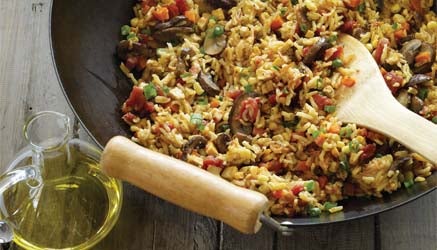Wok This Way

If you own a wok, it probably spends most of its time stored in the cupboard until an Asian recipe calls for using one. But there’s a lot more you can do with a wok than stir-fry vegetables. Its size and shape make it an extremely versatile piece of cookware: The heat at the bottom sears food quickly, while the sloped sides make it easier to stir and toss ingredients without spilling. Also, a wok’s ability to heat quickly and evenly lets you use less oil or fat when cooking—which alone may give that skillet on your stove a run for its money. But don’t just take our word for it. Give these recipes a try to see for yourself.
When To Wok It
Switch out your skillet on these occasions:
Wilting greens
The size of a wok makes cooking large bunches of leafy greens, such as spinach and broccoli raab, a breeze. The high heat at the bottom of the wok wilts the veggies quickly, and because the wok needn’t be covered to cook down the greens, they retain their bright color.
Sauteing delicate ingredients
Fragile fruits and vegetables can be shaken and stirred in a concave-sided wok without crushing or spilling.
Braising
Braising calls for sauteing ingredients first, then covering and simmering, both of which can be done in a wok with a lid.
Deep-frying
No fryer? No problem. The depth and width of a wok make deep-frying foods in oil (such as the Avocado Tempura with Chile Sauce, safe and easy. Culinary bonus: The oil used for frying helps season the wok, so food doesn’t stick in the future.
Making paella and other one-pot dishes
The specific, shallow pans used for Spanish paella and Moroccan couscous, among others, can be replaced by a wok.
Gas Or Electric? Most woks have rounded bottoms to allow a gas flame to distribute heat evenly. If your stove is electric, however, choose a wok with a flat bottom so that it doesn’t slide around and the heating element heats the bottom, not the sides, of the pan.